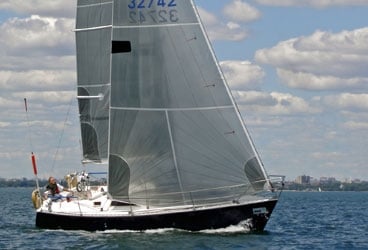
Hunter 31 368 cp
Hunter Marine introduced the Hunter 31 in 1983, and it remained in production for four years. My 1986 Hunter 31, which I named Aquarius, was 3 years old when I acquired it, and it had only been lightly used. I found it fun to sail. It had a real big-boat feel, with tight, cable-linked wheel steering, and it cruised comfortably at 5 to 6 knots. The high bow and unusually high freeboard for a 31-footer made it a dry sailing boat in the normal range of cruising conditions.
This model, in Hunter fashion, was fitted with a B&R rig, which, with its double swept-back spreaders, has a very racy look. The mainsail carries a lot of roach, so even with a 135-percent masthead jib, the boat usually had a slight but pleasing amount of weather helm. Aquarius didn’t do well off the wind, partly due to the swept spreaders, which limited the extent to which the mainsail could be eased. The answer, which is the best one anyway, was to tack downwind. Aquarius wanted a reef early, in maybe 15 knots of wind; the large main has two reef points, both of which I frequently used. I found it fairly easy to balance the sails on a reach but almost impossible to heave to in the conventional way. The boat was too eager to sail and could make 2 or 3 knots with the jib backed and the mainsheet free.
At 9,000 pounds, the Hunter 31 is light enough not to need a windlass; the ground tackle can be paid out and retrieved manually, procedures facilitated by the easily accessed anchor well and bow roller.
The side decks and handholds are more than adequate for safely going forward while under way, and the very large cockpit has ergonomically comfortable seating and more than adequate stowage in the lockers.
Power is supplied by a 16-horsepower Yanmar diesel. The engine compartment has surprisingly good access for a boat of its size, and the acoustic insulation is outstanding.
Belowdecks, the Hunter 31 has a dinette that seats four to starboard, and there’s a settee to port. Because the table is supported by a single leg near the boat’s centerline and the full length of the table outboard, it’s more stable than a typical single-pedestal table. It made a good navigating station in a seaway and could accommodate a full-size chart.
The “real” chart table is small and at the head of the quarter berth on the port side. This berth is tight, with very low overhead clearance and several protrusions to bang into. The V-berth forward is of a decent size.
The simple galley has an Origo non-pressurized alcohol stove with two burners and an oven. The reefer is a well-insulated icebox-a block of ice would easily last three to five days.
The head, forward on the starboard side, is simple but functional. Unfortunately, both the shower sump and the icebox drain into the bilge, which is very shallow. Also, because of the boat’s grid-pattern pan construction, when I sailed Aquarius in a seaway, water would flow to numerous inaccessible areas and not drain directly back to the bilge.
The Hunter 31 is a very practical boat for coastal cruising, and with its simple systems, it’s easy to maintain. I liked the lines of my boat, and seeing Aquarius at anchor from ashore or a dinghy always made me smile.
Jim Swartwout learned to sail on Chesapeake Bay, but his primary cruising area today extends from Santa Barbara to San Diego and includes the ports and islands in between.
Hunter 31
LOA 31′ 4″ (9.55 m.)
LWL 26′ 3″ (8.00 m.)
Beam 10′ 11″ (3.33 m.)
Draft (shoal/deep) 4′ 0″/5′ 3″ (1.22/1.60 m.)
Sail Area (100%) 458 sq. ft. (42.55 sq. m.)
Ballast 3,500 lb. (1,587 kg.)
Displacement 9,000 lb. (4,082 kg.)
Ballast/D .39
D/L 222
SA/D 16.9
Water 35 gal. (133 l.)
Fuel 18 gal. (68 l.)
Engine 16-hp. Yanmar diesel
Designer Cortland Steck and Hunter Design Group








